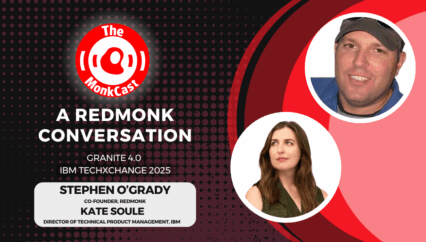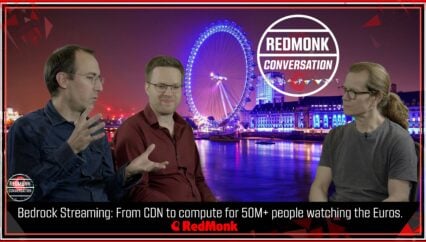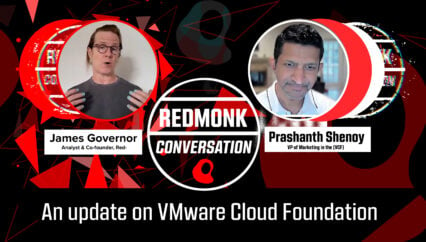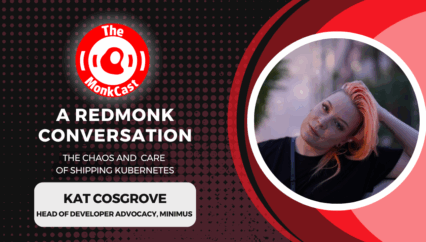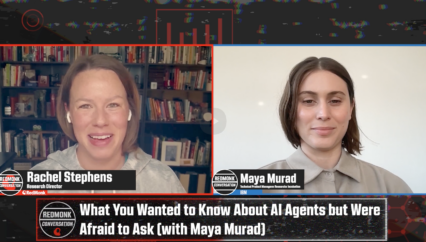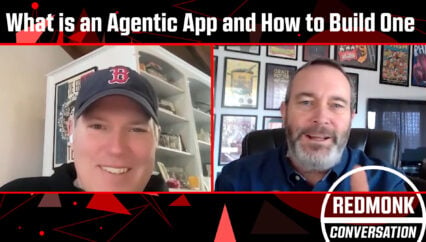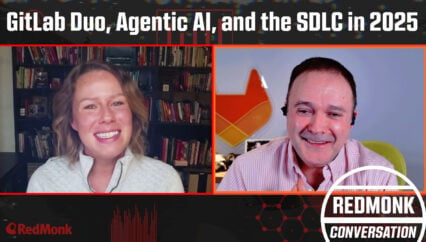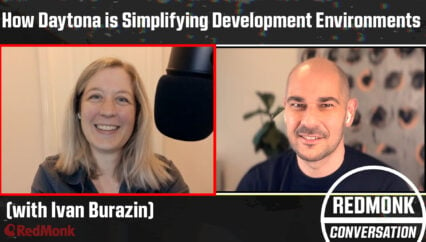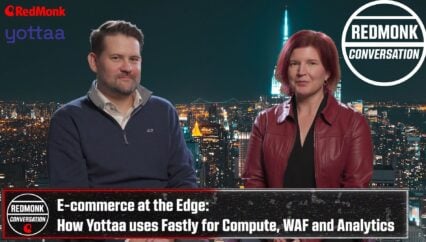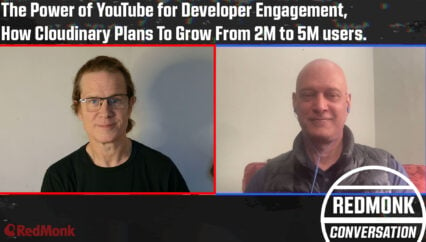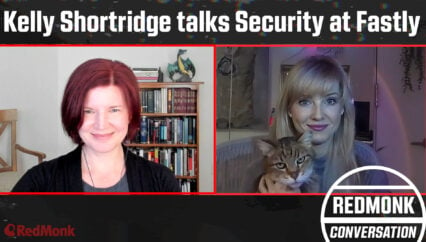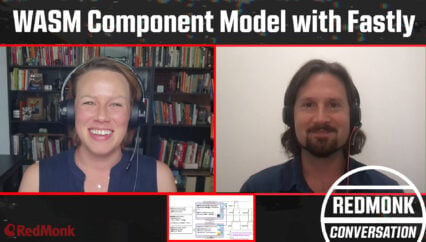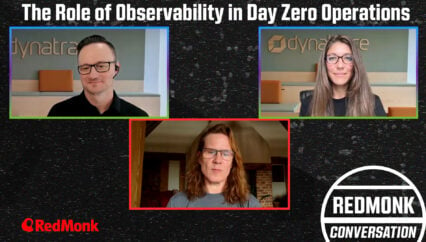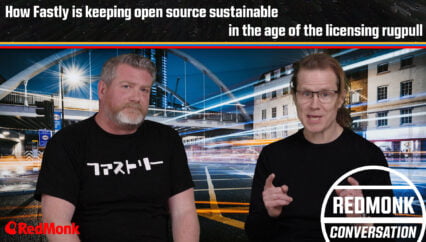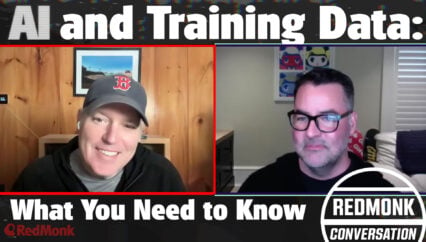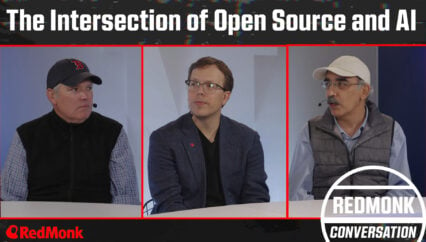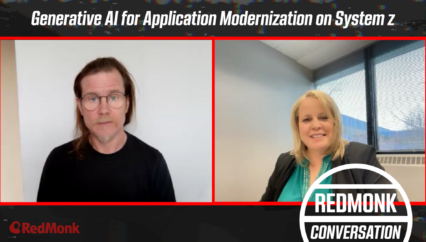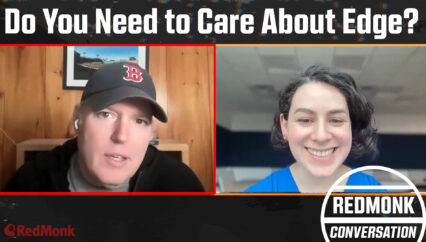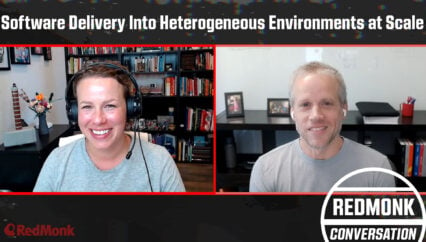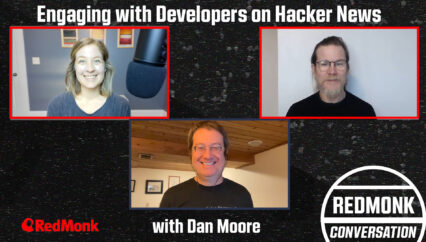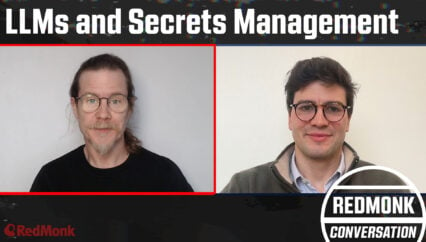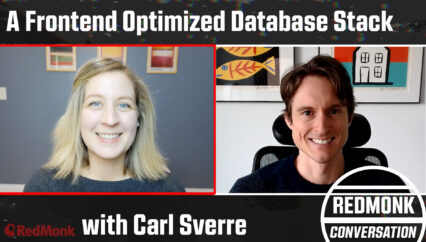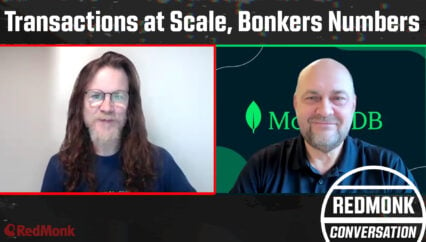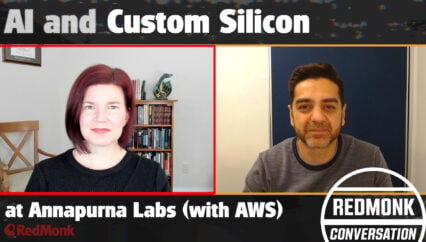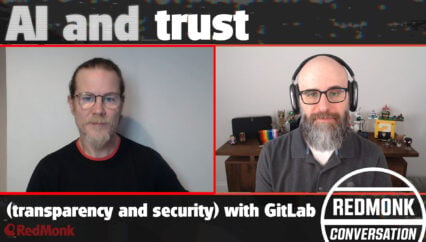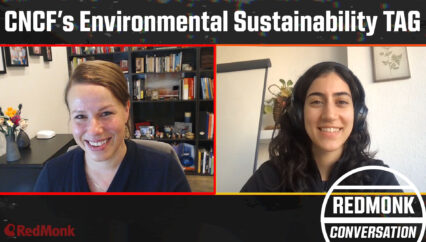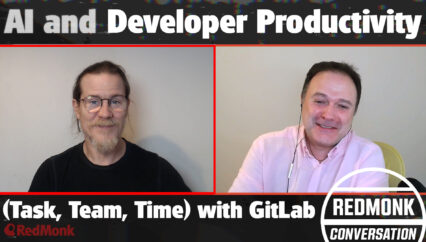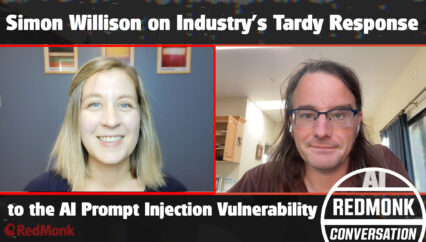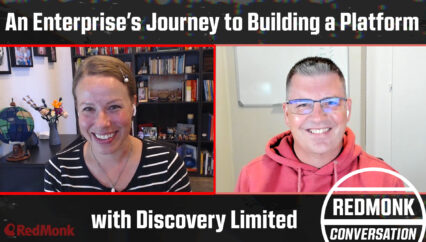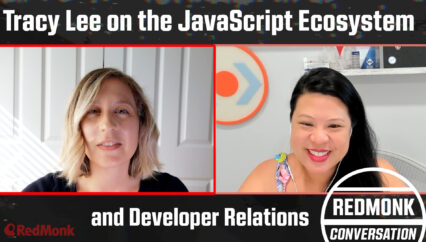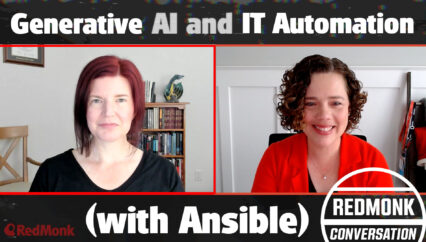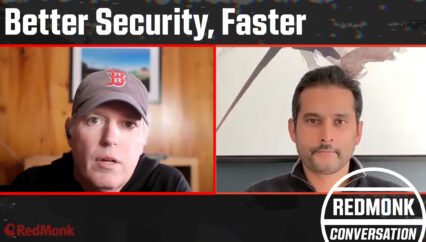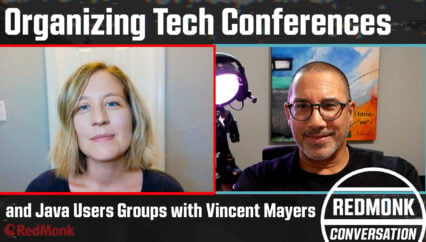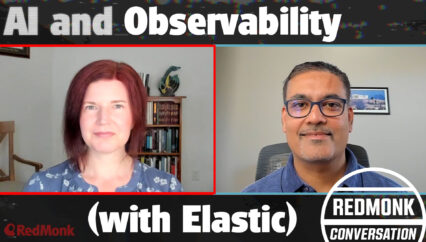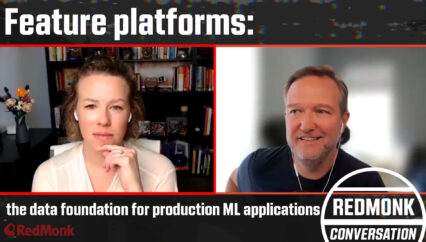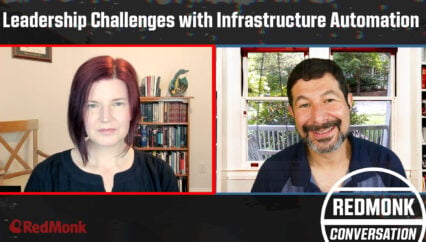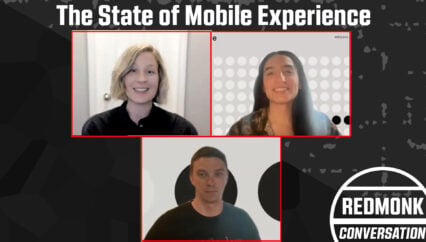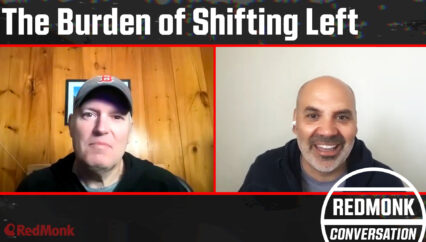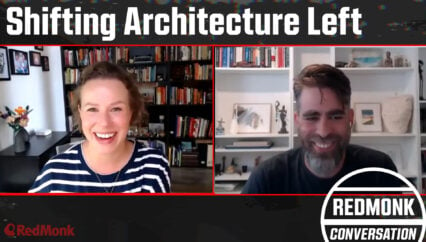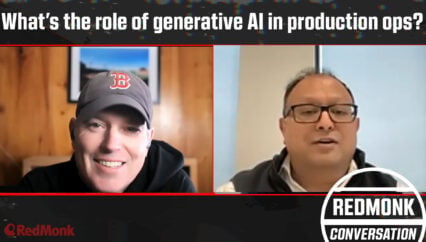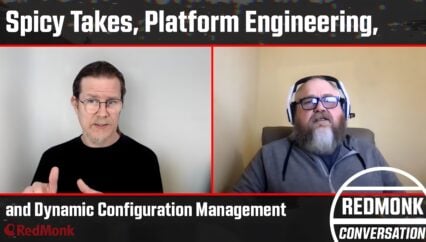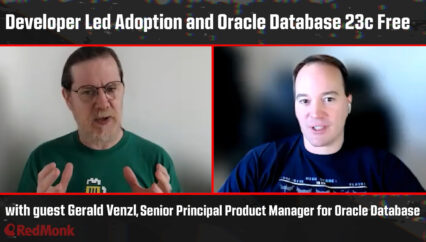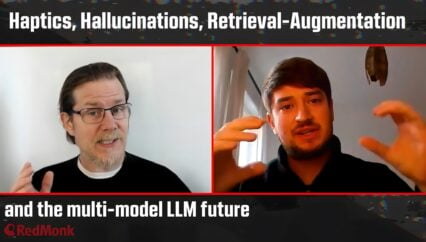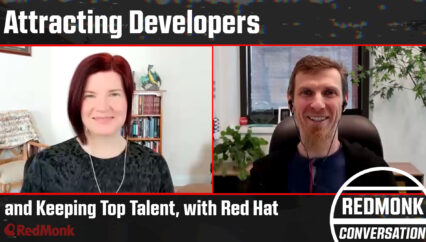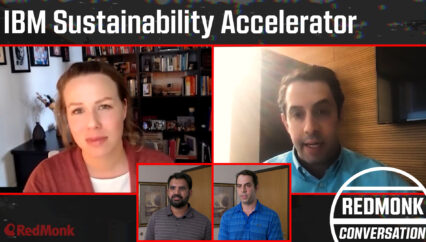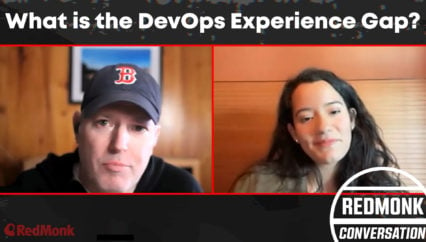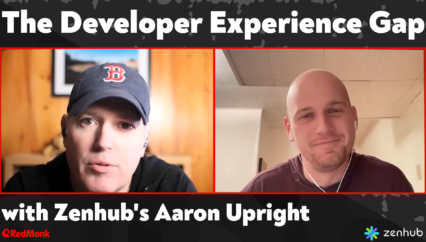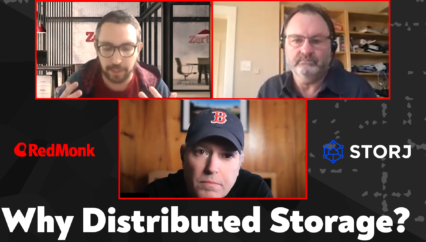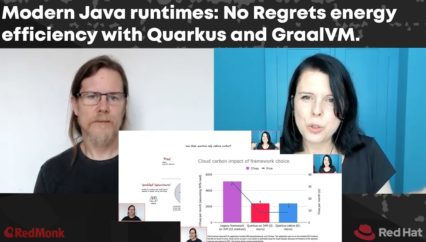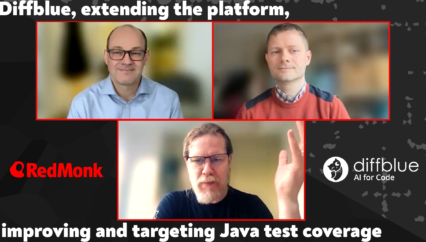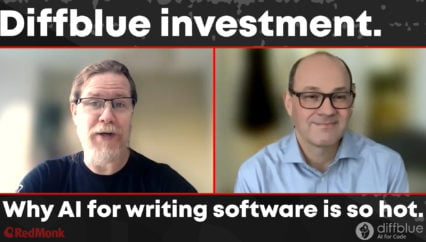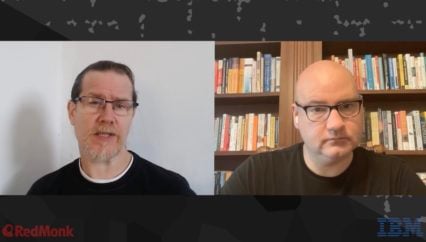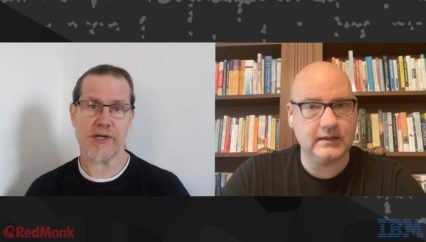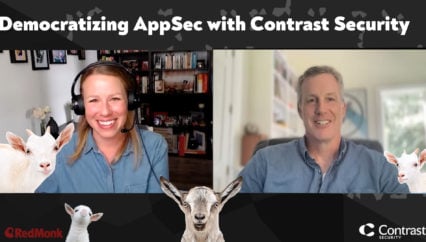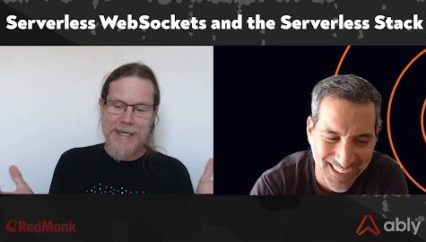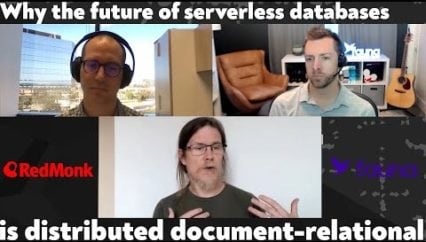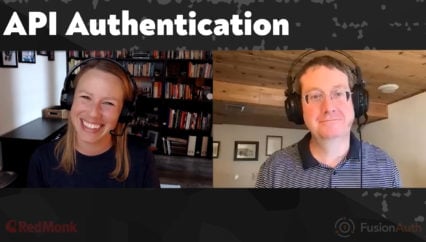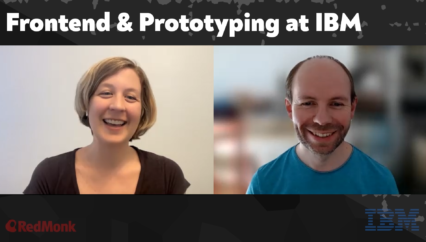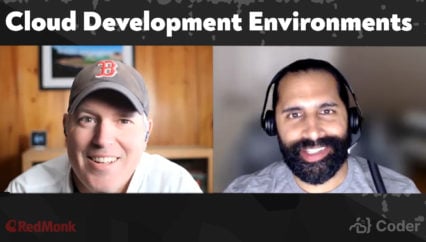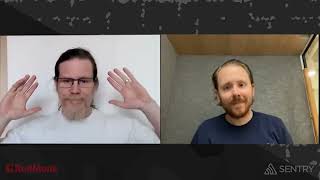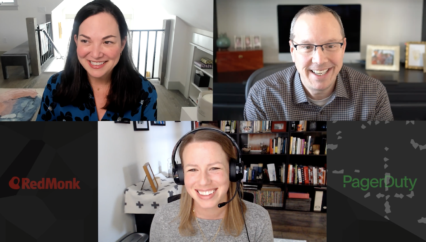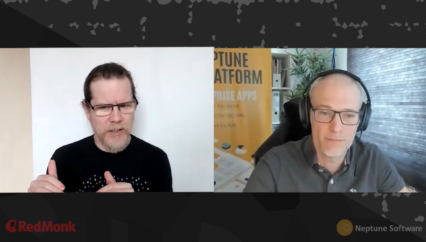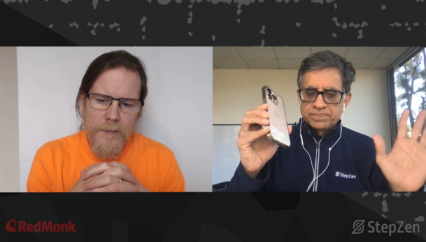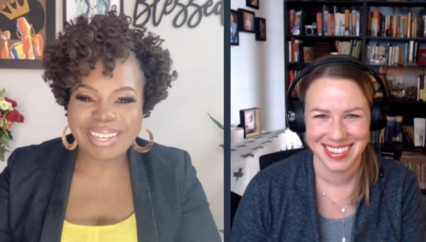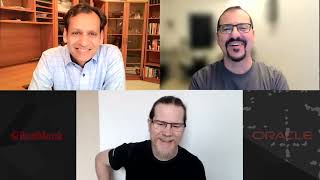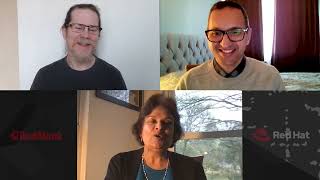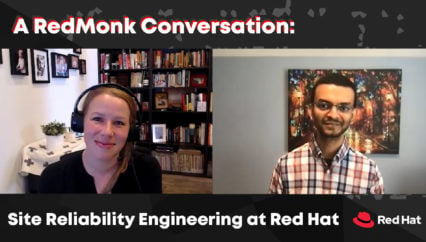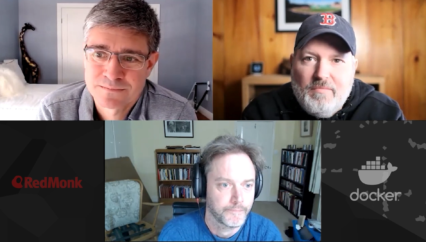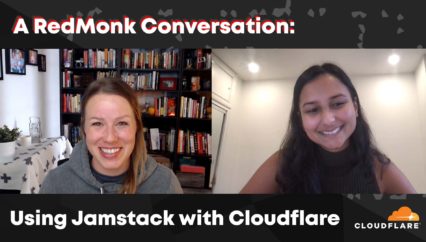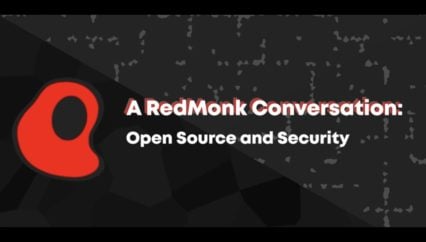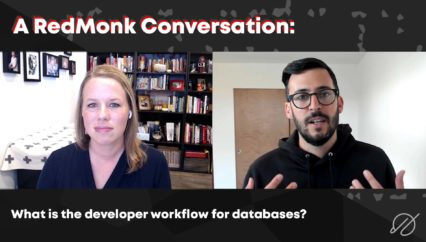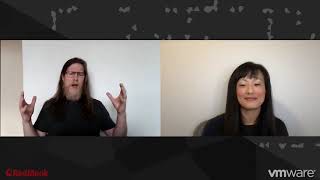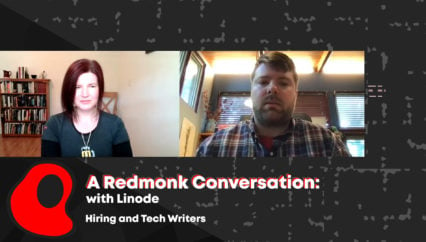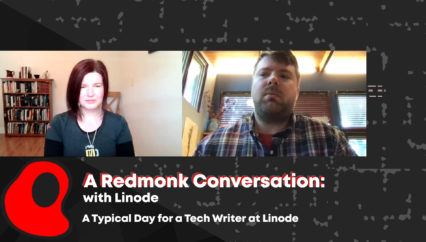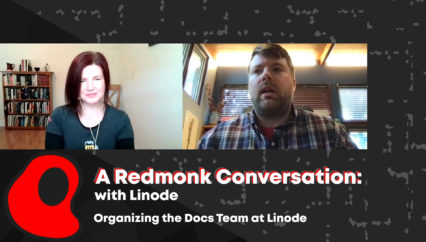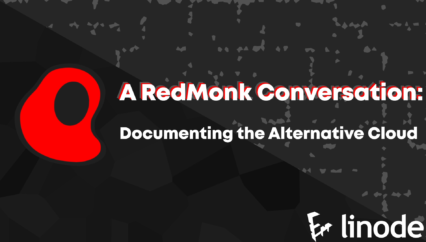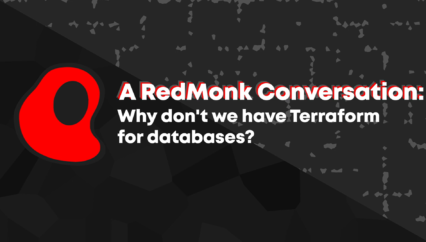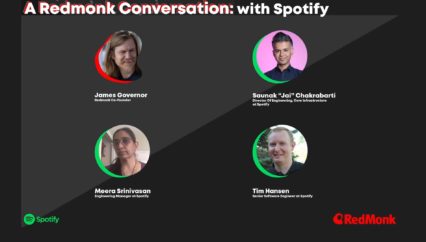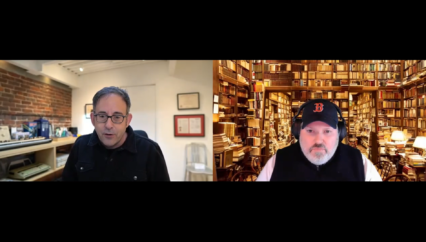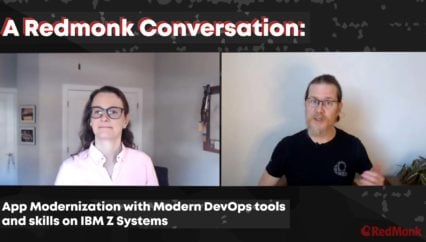Transcript
KellyAnn Fitzpatrick: Hello and welcome. This is Kelly Fitzpatrick from RedMonk. And we are here today to talk about remote work. For some of us, myself included, we’ve been working remotely for a while, but for others, remote work is part of these larger and sudden changes that have been brought on by the ongoing COVID-19 pandemic. So while we will be focusing on remote work today, we’re also going to talk a bit about some strategies around communication and documentation that might actually help teams adjust to what are for some folks, some really, really big changes.
So now onto the good part. Joining me today is Darren Murph, who is the Head of Remote at GitLab, which is a company that offers solutions that cover the entire DevOps lifecycle, and which has been entirely remote, I think, since its inception. And Darren, thank you for joining us today. Can you tell us a little bit about yourself and the path that got you to being the Head of Remote at GitLab?
Darren Murph: Absolutely, Kelly. Thanks for having me. It’s a pleasure to join you today. So I kind of fell into remote work. I loved travel early on, and I love storytelling. So I became managing editor at a consumer technology publication called Engadget. It took me all over the world to cover trade shows, conferences, interviews, and it dawned on me that I was writing and working while traveling all over the world. And that suited me much better than commuting into an office. So I fell in love with remote work because of travel. And I actually managed to visit over 30 countries in all 50 U.S. states while earning a Guinness World Record at Engadget, which goes to show you actually can work remotely and be the best in the world at something. And in fact, I attribute in large part the ability to get that record because I was able to work remotely and ditch the commute.
So that’s kind of where it began. And then all the way till now, I’m the Head of Remote at GitLab, as you mentioned. We have over 1300 people in more than 65 countries with no company-owned offices. And we’ve been that way since inception. So I’ve worked across the spectrum of remote. I’ve worked on some really amazing hybrid environments where I think most of the world will end up in after COVID-19, but being in an all remote environment, it is just amazing to see the level of documentation and transparency and cohesion and efficiency. And I think a lot of hybrid teams and even co-located teams can learn a lot about what we’ve dialed in at GitLab.
KF: There was a really great Fortune article that came out a couple of months ago talking about how you were brought on as Head of Remote at GitLab well before the COVID-19 pandemic, I think it was July of last year. So can you can you tell us a little bit about–for those of us who haven’t read that article or can’t get it because there’s like a paywall–a little bit of a summary of GitLab’s, what now seems like kind of 20/20 hindsight in having this prioritization and emphasis on making sure that remote work works for everyone.
DM: Yes. So the Head of Remote role, I think, is one that you will see proliferate. A lot of companies are realizing that remote is so nuanced, it’s very difficult to just add it as a line item to a Chief People Officer or Chief Operations Officer. It requires a lot of intentionality. And I do think you will see a lot more companies looking for this. When GitLab recruited for this role, obviously it was well before the COVID pandemic, but we were scaling rapidly. We tripled in size in 2019. We were bringing a lot of team members in that needed to acclimate to remote. Many of them came from co-located environments and frankly, a lot of the ways that GitLab works would feel downright troubling in other organizations. We say that there’s as much to unlearn as there is to learn. And we outrightly tell people that the ways GitLab works, it’s not a trap. We truly do try to work with short toes and no ego and blameless problem solving. Our culture is very deep and very specific and a Head of Remote helps to re-emphasize that across the onboarding, across learning and development, manager training, so that’s a good portion of my role, but also when I came in, we had about five guides dedicated to how we do remote.
So if you’re familiar with GitLab, we are very transparent. Our entire company manual called The Handbook is available online. If you Google “GitLab Handbook”, you’ll find it. There are literally thousands of pages in that, but there were only about five or ten of those devoted to remote. So I came in and I started systematically building more and more of these. And now we have bespoke guides on meetings and asynchronous and hiring and compensation. And we wanted to do this for two reasons. One, so our team could read it and internalize it and they would have a single source of truth of how we operate remotely, but also so that companies outside of GitLab in the broader community could benefit from this. We fundamentally believe that making the world a more remote-friendly place is going to be a part of our legacy going forward. And we do that by documenting. So I joined before COVID to start building that library. And now that COVID has happened, it has become an incredible resource for companies all over the world. We’ve heard from dozens of companies, from ten person startups to 100,000 person multinationals that they’re using this as the blueprint for their new go forward plan.
KF: Just imagining myself as someone who is trying to onboard at any point as a remote worker, but especially now, to have that type of process and clarity just has to be amazing. And just such a boon.
DM: Yeah, it is one of the things that suddenly remote companies are struggling with, if they’re onboarding was not well documented or it was intentionally people heavy instead of documentation heavy, it is extremely hard to pivot in real time and GitLab’s template for onboarding is available online. You can see what we go through on weeks one through six, exactly what you have to go through. So it’s very systematic, it’s very well articulated. And everyone goes through the same onboarding process. We also pair every new hire with an onboarding buddy, which is a veteran in the company. And this person can ask as many questions as they want and they can walk through that onboarding journey together. And it really does add a human element to a systematic process. And I’ve advised other companies that you can have that right now. It might take a while to get your onboarding as a whole documented. But there are surely veterans in your company that would love to be mentors to new hires.
KF: I have to say that when I started at RedMonk, Rachel Stephens was my unofficial–what I will now term–onboarding buddy, and she’s amazing. So, of course, I had a really good onboarding experience. So shifting a little bit, what are some of the changes that you have seen or you have had to make with the onset of the COVID-19 pandemic (which we’re almost six months into now)?
DM: Yeah, one of the big changes is about 20 percent of our company actually works outside of their home. So at GitLab, it’s not exclusive work from home. We will support people if they want to work outside of the home. We realize that not every home is amenable to remote work. Some people live in very small spaces. They have a spouse that’s home. Maybe there’s homeschooling going on. And so we would allow people to submit expense reports for coworking spaces or communal centers like Codi. And about a fifth of our company did that on a somewhat regular basis. And now they’ve all been thrust back into their home. So that has been a bit disorienting for them.
The second big thing is parents. We have a lot of parents around the world and most of them now have kids back at home. And if you look forward into the fall, a lot of them will be doing remote schooling. So we’re trying to figure out how to distribute the work and make sure that we support our parents so that they can be there as a teacher aide while also working at GitLab. It is a Herculean challenge that a lot of companies are going through.
And the third thing is the invention of the Family and Friends Day. So one of our sub values is “family and friends first and work second.” And we do everything we can to reiterate and reinforce that. But we saw in the pandemic that productivity was actually going up. And so although we were saying and telling people to prioritize well-being, prioritize their mental health, take care of themselves first, for a lot of people, when there’s nowhere to go or you feel very constricted from travel, you just end up defaulting to something that you’re familiar with, which can be work. And so the Family and Friends Day are deliberate Fridays that we take off, the entire company takes the day off. And we actually stood up a slack channel for Family and Friends Day that we encourage people to share photos, videos, and stories of what they’re doing on their day off, whether that’s riding a bike or reading a book or something other than work. And seeing that photo roll come in from 1300 people all around the world is really encouraging. And it reminds us that, hey, even if we can’t go as many places as we would like, there are still really cool ways to connect with family, neighbors, and community.
KF: I love that practice and I need to talk to the other monks and figure out how we can incorporate that into our RedMonk calendar. So you have tweeted and you have also written about GitLab’s handbook-first approach to documentation. And this is how you ended up on my radar, of course, because I love all things documentation. Can you tell us a little bit about this approach and how it fits in with GitLab’s larger view about documentation and communication and then, of course, remote work.
DM: So we’re careful to say handbook-first instead of documentation. And the reason there is that documentation could be interpreted differently, depending on who you ask. In fact, you may have your finance team documenting their processes in a Notion doc, and your HR team documenting their processes in an Almanac doc or a Google doc, and they don’t even talk to each other. So the practice of documentation without a systematic approach doesn’t really solve a lot of organizational challenges. So at GitLab we have our handbook. It is written on GitLab the platform, we use, GitLab to build on it, to iterate on it. So we use our own product to build our own handbook. And that is the single source of truth for everything at the company. And it is ingrained in our culture that it must be in the handbook or it’s not true.
And because we reinforce that company-wide, if you ask someone for something and they can’t answer it with a link, it’s a red flag that that answer needs to be in the handbook because we have no idea how many other people on the team are asking that exact same question. And it’s massively inefficient to have to verbalize that instead of being able to point someone to a link.
So that is the genesis of the notion behind handbook-first and why we want to work handbook-first and why it extrapolates the efficiencies over time. It takes intentionality for this to work. It can’t be something that you just give lip service to. This really has to be baked into your value set and how you actually get work done and you’ll see it reiterated at GitLab. If we’re in a meeting and someone starts talking about a project and they pull up a PowerPoint, for example, inevitably someone on the call will say, well, is this linked or embedded in the handbook? Can we screen share the handbook instead of the slide deck? Because that’s a more accessible link. That’s a more inclusive way to communicate. But it’s baked in and people know what they’re getting into when they sign up to work at GitLab. You have to love low-context documentation. This is just kind of how we work.
It is much more difficult for suddenly remote companies to get to this point because many people have opted into an atmosphere where it’s verbalization first and documentation either only if you want to or it’s not really enforced at all. And now you’re seeing that documentation is a vital part of a cohesive, remote team. The one thing I’ll say there is for team leaders that do go through the trouble of making documentation a value, it will pay dividends down the road because it’s not remote exclusive. This will make even co-located teams much more efficient. They’ll have to rely on meetings and synchronicity much less because things are written down. So it’s worth doing even if you do plan to migrate to a hybrid remote team or in fact go fully co-located after COVID. Documentation is still something that should be considered and be at the heart of your operation. Fundamentally, it makes you more disciplined, and talented people want to work at disciplined companies.
KF: I found that documentation that I have created to communicate or set things for other team members has benefited me, especially because I don’t have to rely on my own memory of how something happened a certain time. It’s like we’ve written it down, it’s there. But I love this idea that you can’t just throw documentation at something and it provides this magical solution. But there has to be this kind of like process and especially, as you said, discipline that goes along with it.
DM: You have to think handbook first instead of verbalization first. And it takes a lot of reinforcement to get this right. It is not the default. I tell people that it’s going to feel awkward until it doesn’t. And honestly, it’s one of our remote first forcing functions. And I don’t think it’s coincidental that the word “forcing” is in there. These are things that do not come naturally by default, but over time, documentation matters so much. And for new leaders that are on small teams, you have five or ten people you may think “we don’t need to document. Everyone can talk to each other,” but it’s so important to do it now because it’s so much easier with five or ten people. And when you scale to 100 or 500 or 1000 people, it only gets more important as you go and more painful to do it with each additional day that you let pass.
KF: I’m already imagining the transcript of this and the pull-quote that I will have that “Over time documentation matters more and more.”
DM: Yes, it has exponential growth. It’s a compounding effect of greatness. So start now and you will see the dividends from that for years to come.
KF: Speaking of the future, what direction are you hoping to take remote work at GitLab and/or do you have any kind of predictions of what you think we’re going to see in terms of remote work trends in the industry at large?
DM: I think–well, I hope–that remote work gets even easier as new tools and technologies come online. I do think that the pandemic will create this new era of focus and innovation on creating tools that will enable remote teams to function better. We use GitLab to collaborate on all of our projects, and we have a very specific way of running meetings. Every meeting has to have a Google doc agenda attached to it, and every meeting has to have temporal documentation that happens in that meeting. And after the meeting is over, the meeting organizer has to look at key takeaways and then merge those key takeaways into the handbook. We do this for a couple of reasons. One, we want to make meetings really difficult. We would much rather the work just happened in a GitLab Issue. So we’re going to do everything we can to discourage you from having a synchronous meeting because we want more people to be available to add feedback. And if you have a meeting at a certain time, on a certain day, chances are there’s a good chunk of the people that need to be in that meeting that aren’t even awake, they’re on the other side of the world. And so we do this to force people to think about work differently and to not just default to having a meeting.
But one of the things and the reason I bring this example up, one of the things I’m encouraged by is the advancement of artificial intelligence as it relates to machine learning and language translation. I have this concept of a program being along for the ride in a meeting where it’s able to listen in and not just transcribe, which we’re already able to do, but then take that transcription and listen to pauses in someone’s voice or listen to the changing vocal tones and know that it’s switching from one person to another and actually picking up on keywords like “finance” or “people operations” and then making suggestions on where these pieces of information should live in the handbook. And maybe there’s an API link where it makes a proposal to make our handbook better based on what was just verbalized, and then it will assign it to the people that were in the meeting. And if we need to tweak it, we can. That would make meetings a lot easier. We would have much less manual process in making our handbook better. So the bottom line there is I think that there are tools and technologies on the horizon that will make it much easier for us to work handbook first and for documentation to feel much less like a short term burden. I think most people would be OK with documentation if it weren’t so time consuming. And I do think that we’re on the precipice of a lot of tools enabling documentation to be much more effortless than it is today.
KF: I mean, I certainly hope so, and I can see applications for the type of AI/ML product that you just described in many other ways outside of how to make your meetings–that you don’t want to have that often because you don’t want to have them–how to make them better when you have to have them.
DM: Yes, absolutely. Absolutely. And from a second and third order impact, I do think that remote work is going to fundamentally change how we think about small, midsize, and even large towns. Right now you have small and mid-sized communities that feel like they have to lobby for a corporate to come in and build a skyscraper and bring a certain amount of jobs to improve the tax base. But we’re not far off from town council members saying let’s just build great green spaces, great medical facilities, great access to things like grocery stores and salons and coffee shops. Let’s just make a really livable city and then just let people bring their jobs there. People are yearning for community. We have acknowledged and seen that more than ever with COVID. We are relational, communal beings and it is devastating to not be able to plug into community. And I think that coming out of this, community will be more important and more magnified than ever. And when you’re able to decouple geography from the results that you drive, imagine millions of people being able to optimize where they live and who they’re able to care for and the communities that they impact. And it’s not dictated by where they have to live to earn a paycheck. This one concept has the potential to massively change how society operates, just the level of joy, happiness and impact that we can all have if we don’t have to work life around the rigid schedules of work. I’m really encouraged by that. I’m definitely a long term optimist on how that’s going to transform people’s lives and small and midsize towns.
KF: Just speaking from personal experience, when I when I took the job with RedMonk, I did shift to working fully remote, whereas before I was working primarily at university campuses. And being able to design my life not around work, but work allowing me to do what I wanted and be around the people that I wanted to be and be able to get to friends and family. And as you said, the communities that we’re all missing dearly right now. But, you know, the idea of being able to see them all again at some point is so very much a light at the end of the tunnel, for me at least right now.
DM: Yeah, and it’s not just good for people, it’s good for business. We do this because it makes our business stronger. We have a naturally more inclusive and diverse workplace. We have people from 65 countries and regions that are able to pour local cultural understandings back into our products and back into our culture. This is much stronger than manufactured diversity, where you try to recruit people from different countries but then relocate them to an entirely different country. It is amazing what it does for business. It opens up your recruiting pool. So I think more and more companies are going to see this coming out of COVID. And there’s been a lot of preconceived notions that have been broken down about what jobs can and can’t be done remotely. Turns out many more than we thought actually can be. And this is even during this suboptimal time. I do think that companies, if they can stick it out and build some remote muscle through this, they’ll be really, really in a great position going forward.
KF: So thinking about some of those companies or organizations that are thinking of moving from remote work as a kind of temporary solution in a pandemic, to a more careful and planned strategy, what type of advice might you have for those folks?
DM: First of all, get a remote leadership team or Head of Remote and I’ll dive into that. The second thing is get a documentation strategy and stick to it. And the third thing is re-evaluate your culture and your values.
So I’ll touch on the first one. Remote is so nuanced that you’re really going to need to put a lot of brainpower on getting it right. So whether that’s hiring a Head of Remote, or pivoting your Chief People or Operational Officer to focus specifically on this for now and then building a team around it. I’ve seen some companies have a remote leadership council where they dedicate executive time each week or they’ll hire people that have experience leading remote transformations. Look, this is new. There are a lot of leaders that have done well in their career but have no experience whatsoever leading a remote team. And it’s totally OK. There is expertise out there. It’s a bit hard to find and in high demand, as you can imagine right now. But it’s worth putting the brainpower into it because remote is not a binary switch that you flip. This is something that you’re going to need to put quarterly and annual goals on. For example, if you want to become 50 percent more asynchronous year over year and have 50 percent less meetings with the same amount of productivity, you will need quarterly milestones of what you’re going to accomplish quarter over quarter to achieve something much larger. You’re fundamentally rearchitecting how you do work. This is no small task. This is not trivial. And even communicating that out to your team members on how the work will begin to shift is a massive undertaking that’s going to require perpetual attention and iteration over time.
The second part of the documentation strategy, we talked about this earlier, but if things aren’t written down, if people don’t have a single source of truth to go to you will see chaos at scale. Communication silos will happen. Communication fracturing will happen. So you’re going to have to have a documentation strategy and be intentional about it and document how you document. It’s going to be part of how you deliver that message to your team. So that’s where I would start. And then you’ll start to see what else you need to to go after.
One thing I didn’t mention that I will now is ask your team for feedback. You don’t know what new perks are needed. You don’t know what stipends are needed for workspaces, everyone’s going through this a little bit differently. Instead of trying to put a plan in place that you think will positively impact the most of your team. Put out a survey. Just ask people. Everyone’s going through something a little bit differently. You want to be able to support the most people that you can.
KF: I love this idea of it being this kind of iterative and adaptive thing, it sounds almost like training for a marathon in some ways, that you can only do a little bit at a time and then you have to keep putting that training in until you finally kind of get there. And there’s always the next marathon.
DM: There’s always the next thing. And GitLab’s been doing this from inception and we’re still figuring out ways to get better at remote. We have an entire guide on how we do informal communication and relationship building. We added a new one just a few months ago in the pandemic. We noticed that a lot of parents have kids at home and we thought, hey, what if the parents synched up schedules, open up their Zoom cameras and then let their kids kind of sing, dance, show off toys, and enjoy cultural exploration across six continents while they’re quarantined at home? And we coined this “juice box chats,” which is a play on the coffee chat, basically the adult version of just grabbing coffee with someone and chatting about anything. And it’s been a huge hit. Kids around the world now are able to hang out with each other. Parents get a reprieve. And so that’s not something that we thought of nine years ago. It took a pandemic for that to happen. But we’re constantly iterating on this and constantly figuring out ways to get better.
KF: So last question. I noticed that you have upcoming on August 26 GitLab’s Commit conference, and there is in fact a I think it’s called the “Remote but Connected” track for that conference. Are you allowed to tell us a bit about what we can expect in that track?
DM: I’m super excited about this. This is our first ever GitLab Commit user conference with a remote work track. And remote is such a core part of who GitLab is and it’s more timely than ever. We have eight amazing speakers. Look at my Twitter @darrenmurph or my LinkedIn. I actually just put out a post today and tagged all of the amazing speakers. We have people coming from Netsells and HubSpot and Friday and Mattermost, just an incredible array of people that have a diverse array of experiences on remote work. Some of our speakers are actually suddenly remote themselves and they’ve just been thrust into this. And so we’re trying to meet people where they are and give them actionable takeaways to make their life better as a remote worker. It’s free. You just go to GitLab.com or search for GitLab Commit. You can register, it’s free. You’ll be able to replay it. It’s a 24 hour event with lots of DevOps content as well. And we’ll have a virtual booth there where people can connect and ask questions in real time.
KF: Well, I will get my coffee and my juice boxes ready for that particular event.
DM: Awesome.
KF: Darren, thank you so much for spending some time talking with us today. I feel like we covered a lot of ground in a short amount of time. But of course, there’s, I think, a lot more things to talk about and hopefully we’ll see that at GitLab Commit in the coming weeks.
DM: Absolutely. Thank you. I’m happy to do it. For folks that are listening, check out AllRemote.info That will get you straight into the remote section of our guide. And I’ll be sure to share some links that we can put in the description as well.
KF: We’re getting so many links in this transcript. It’s going to be great. All right. Thank you.
DM: Cheers. Take care.
Links to Cited and Additional Resources
- Fortune article about Darren’s role of Head of Remote at GitLab (paywalled): https://fortune.com/2020/05/28/coronavirus-head-of-remote-work-from-home-gitlab-github-jobs/
- GitLab’s Handbook: https://about.gitlab.com/handbook/
- Darren’s tweet on GitLab’s handbook-first approach: https://twitter.com/darrenmurph/status/1263569370405617673
- Write up on GitLab’s handbook-first approach: https://about.gitlab.com/company/culture/all-remote/handbook-first-documentation/
- GitLab Commit Conference page: https://about.gitlab.com/events/commit
- RedMonk <> GitLab Remote Work Deep Dive: https://learn.gitlab.com/redmonk/
- GitLab’s Guide to Remote Work (the AllRemote.info URL also resolves to this resource): https://about.gitlab.com/company/culture/all-remote/guide/
- Living The Remote Dream (Darren’s book): https://www.amazon.com/Living-Remote-Dream-Setting-Advancing/dp/1506192130
Disclosure: GitLab is a RedMonk client; however, this video is an independent piece of work and was not commissioned by any entity.
